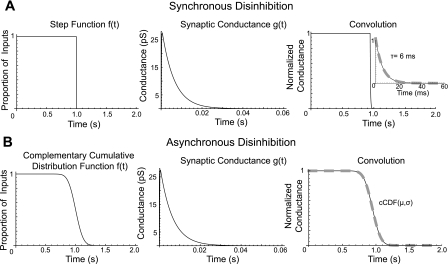Fig. 4.
Modeling the time course of disinhibition of substantia nigra pars compacta dopaminergic neurons. A source of tonically active inhibitory inputs was turned off synchronously (A) or asynchronously (B). This is represented by a step function (A, left) or the complementary cumulative distribution function [f(t) = cCDF (mean μ = 1.0 s, standard deviation σ = 100 ms)] (B, left). Each input is described by the conductance waveform g(t) (middle) with a deactivation time constant (τ) of 6 ms. The time course of disinhibition is determined by their convolution [f*g](t). Thus tonic inhibition decays according to the GABAA deactivation time constant (A, synchronous) or the complementary cumulative distribution function (B, asynchronous). The time at which an individual GABAA input in the asynchronous case is removed is taken from a normal distribution.

